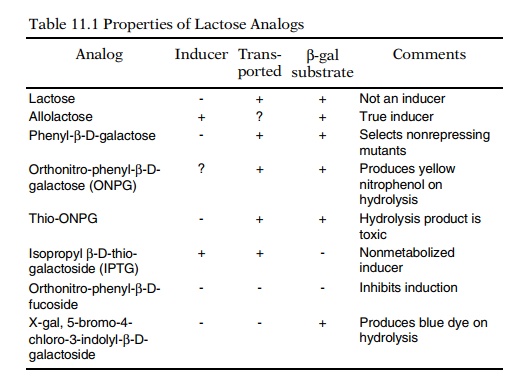Chapter: Genetics and Molecular Biology: Repression and the lac Operon
Role of Inducer Analogs in the Study of the lac Operon
The Role of Inducer Analogs in the Study of the lac Operon
Compared to progress on many other problems in
molecular biology, research on the lac
operon proceeded rapidly. In part, this was due to the fact that measuring the
response of the lac operon to changes
in the cell’s environment was easy. Addition of lactose induces the operon a
thousandfold, and the assay of β-galactosidase
is particularly simple. Another important reason for the rapid progress is that
many useful analogs of lactose can readily be synthesized. These analogs
facilitate the assay of the lac
operon proteins as well as simplify the isolation of useful mutants.

The properties of several analogs are shown in Table 11.1. ONPG is particularly useful as its cleavage yields galactose and orthonitrophenol, which when ionized at basic pH is bright yellow.
This provides a simple and sensitive assay for β-galactosidase which requires only a measure-ment of the optical density
after incubating enzyme and substrate. IPTG is useful in inducing the operon
for two reasons. First, IPTG induces by binding directly to the repressor so
that the presence of functional β-galactosidase
in the cells to generate the true inducer is unnecessary.Second, IPTG is not
metabolized. Therefore its use for induction does not disturb the metabolic
pathways of the cell as might be the case for induction by lactose.
Phenylgalactose is another useful analog. It is not an inducer, but it can be
metabolized if β-galactosidase is present to
hydrolyze it. Therefore only permanently derepressed cells grow on medium
containing phenylgalactose as the sole carbon and energy source. Such
permanently induced mutants are called constitutive and result either from
defective repressor that is unable to bind to the operator or from mutant
operator that is no longer recognized and bound by repressor.
Related Topics